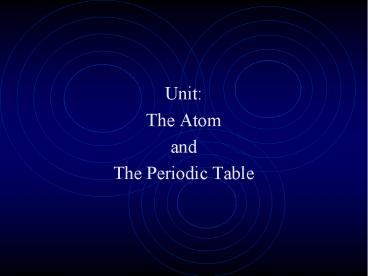The Atom PowerPoint PPT Presentation
Title: The Atom
1
- Unit
- The Atom
- and
- The Periodic Table
2
Evolution of the Structure of an Atom
3
Daltons Atomic Theory
- All elements are composed of indivisible
- particles called atoms
- Atoms of the same element are identical. The
atoms of any one element are different from those
of any other element. - Atoms of different elements can physically mix
together or chemically combine with one another
in simple whole number ratios to form
compounds.(law of definite composition) - Chemical rxns occur when atoms are separated,
joined, or rearranged. Atoms of one element,
however, are never changed into atoms of another
element as a result of a chemical reaction.(law
of conservation of mass)
4
J.J. Thomson
- discovered the electron
- plum pudding model
5
Rutherford
- discovered the nucleus
- Proposed electrons surround the nucleus in a cloud
6
The Atom Today
- The atom is the smallest particle of an element
that retains the properties of that element - Atoms can only be seen with proper
instrumentation - Daltons Atomic Theory wasnt completely correct
- Atoms can be broken down into subatomic particles
- Atoms of the same element are not identical
7
Properties of Subatomic Particles
8
Distinguishing Between Atoms
9
Atomic Number
- Number of protons in the nucleus of an atom
- Identifies the element
- Elements are listed on periodic table according
to atomic number
10
Atomic Number
11
Atomic Number
12
Atomic Number
- atoms are electrically neutral
- protons electrons
13
Mass Number
- total number of protons and neutrons in an atom
- It is not found on the periodic table but can be
estimated
14
Shorthand Notation
15
Fill in the following table
16
Isotopes
- Atoms that have the same number of protons but
different numbers of neutrons - Differ in their mass number
17
Isotopes
- the existence of isotopes was not predicted by
Dalton, who said atoms of the same element are
the same
18
Isotopes
- identified by their mass , write the name of
the element then a hyphen with the mass number
19
Isotopes
20
Uses of Isotopes
- C-14 archeological carbon dating
- Am-241 smoke alarms
- I-131 treating thyroid disorder
- Co 60 cancer treatment
21
Atomic Mass (atomic weight)
- weighted average mass of the atoms in naturally
occurring samples of the element
22
Atomic Mass
- reflects the mass and the relative abundance of
isotopes as they occur in nature
23
Atomic Mass
- To calculate the atomic mass of an element
multiply the atomic mass of each isotope of the
element by its relative abundance, then add the
results - atomic mass mass1relabd.1 mass2rel.abd.2...
24
1. Calculate the abundance of fictitious
element Nv2. If the mass of 293Nv is 293.15 amu
(red)and that of 295Nv is 295.15 amu
(blue), what is the atomic mass of Nv? .
25
Periodic Table
- _______________ was the first person to find a
way to list elements in order of increasing
atomic mass
26
Periodic Table
- He constructed the first periodic table in 1869,
an arrangement of the elements according to
similarities in their properties.
27
Mendeleevs Periodic Table
28
Periodic Table
- In 1913, ______ determined the atomic number of
atoms and arranged the modern periodic table
according to atomic number .
29
Modern Periodic Table
30
Modern Periodic Table
- Each element is identified by its symbol placed
in a square
31
Modern Periodic Table
- The horizontal rows of the periodic table are
called _____ - There are ___
32
Modern Periodic Table
33
Modern Periodic Table
- Each vertical column is called a ____ or ____
- There are ____.
34
Modern Periodic Table
35
Periodic Table
- A periodic law means that physical and chemical
properties of elements are functions of their
atomic numbers - Elements in the same group on the periodic table
have similar properties
36
Modern Periodic Table
- Group A elements are called the representative
elements because they have a wide range of
chemical and physical properties - Name the groups in Group A
37
Modern Periodic Table
- Group B elements are called the ______________
- The inner transition elements are the ______ and
_____
38
Modern Periodic Table
39
Modern Periodic Table
- The representative elements can be divided into
three broad classes Metals, Nonmetals, and
Metalloids - What are some characteristics of each?
40
Modern Periodic Table
41
Niels Bohr
- credited for a model of the atom that states that
electrons are at specific distances from the
nucleus of an atom
42
Bohr Models
Energy Level 1 2 3 4
ELECTRONS
43
Bohr Models
- Exception Outermost energy level can only hold
up to 8e- - You need to be able to diagram Bohr models for
1-36 excluding transition elements
44
Bohr Models
- Do you notice any trends with the group or
period of the periodic table?
45
Bohr Models
- Trends
- Group numbers (1-8A) predict valence electrons
(electrons in the outmost level). - 2. The period tells you how many energy levels
you have in the atom.
46
(No Transcript)

